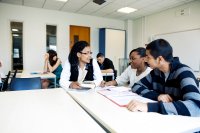Ramping Up Student Performance
Techniques for introducing new material and feedback to students throughout a lesson—a way to spark deeper insights and learning.
Your content has been saved!
Go to My Saved Content.Many pedagogical activities focus on completion as an end goal. Although students can gain new knowledge and skills by completing an activity, they may remain at the same level of understanding. But introducing new information, feedback, or an opportunity for reflection at a pivotal point during a lesson can ramp up student performance. A mid-activity intervention can prompt students to ask more critical questions, elevate their thinking, refine their skills, and subsequently advance their learning.
Introduce New Input
In a recent high school history class, students discussed whether Lincoln should be regarded as the Great Emancipator, using the Gettysburg Address and the Emancipation Proclamation as primary sources to inform their discussion. Based on this initial analysis, students uniformly awarded Lincoln this posthumous title.
At this pivotal point, the teacher offered additional documents to question this shared assumption. The new information challenged the accepted narrative surrounding Lincoln, and highlighted some of the ways in which his views did not respect the equality of all people. Introducing these materials created a divergence of opinion and a more engaging, spirited conversation.
Students began to generate new questions based on this surprising discovery: Was Lincoln a “flip-flopper”? Was he a pragmatist that tailored his remarks to his audience? Was Lincoln open to new information and insights that allowed for his position to evolve? Students worked to reconcile contradictions and re-examine Lincoln as a leader. This burst of intellectual energy was sparked by the introduction of new content.
In a lesson on persuasive writing, Kate Roberts introduces the skill of writing a strong counterclaim after students have developed an initial draft. She pauses to teach about counterclaims only when the students have reached the stage of solidifying their own opinions. Because she teaches this skill when it’s relevant to the learner, rather than front-loading it at the start of the unit, students are primed to implement this more nuanced instruction.
Offer Actionable Feedback
Teachers often use formative assessment—for example, an exit ticket or a culminating discussion—to inform their instruction at the end of a lesson. This timing delays the feedback to the learner by at least 24 hours, hindering its potential effectiveness.
In the same way that a sports coach offers ideas for improved performance throughout a game, or a music instructor offers specific feedback when a song is out of tune, educators should seek to provide immediate assessment of student work. Without mid-course feedback, the same mistakes are likely to be repeated.
As learners, we require specific actionable feedback and the opportunity to adjust our thinking or performance in order to improve. Consider a middle school science project where students were tasked with developing an ice pack for the school’s traveling sports teams, even without access to a freezer. First, students submitted a drawing of their design and received feedback based on how well they met the project’s criteria and constraints such as materials utilized, size, and valid reasoning. In addition to teacher feedback, peers offered written feedback. Students then had the opportunity to make adjustments and improve their design before creating the final product.
Similarly, when students are working in small teams, teachers can pause the group work and stipulate that the students garner feedback as to how well they’re collaborating, individually and collectively. This allows the group to return to their task and focus on the identified areas to improve their collaboration and work quality.
Allow Time for Self-Reflection
Learners who know the desired end goal are better able to assess where they fall on the continuum of mastery than those who do not have a clear performance goal. Self-reflection against an established goal tends to be easier to accomplish on the athletic field, in the art studio, or on the theater stage because the performance and impact are transparent. However, it can be a powerful tool for educators to utilize in the classroom setting.
In the school setting, a rubric is frequently used as the final audit of student performance, but it could be used as a means for improvement. For example, in a Spanish class, prior to a “speed dating” activity in which students have successive conversations centered on a topic like immigration, the class can review an interpersonal rubric while the teacher sets expectations about what she’s looking for during the activity, such as comprehensibility and vocabulary use.
Midway through the activity, the teacher pauses and offers students time to reflect on how well they are being understood, sustaining the conversation, and incorporating recently introduced vocabulary. Students then set new individual goals before resuming the activity. This opportunity to pause, reflect, and set new goals against the desired criteria enables students to make improvements in their language form and function.
Overcome Intellectual Inertia
Employing strategies to overcome intellectual inertia can have an impact on students’ thinking. Practice doesn’t necessarily make perfect, but it can make learning permanent. By carefully designing lessons that introduce meaningful information and time for reflection at critical moments, teachers can serve as a catalyst to spark students’ ideas and insights. In turn, this increases the students’ capacity to deepen their understanding, sharpen their skills, and transfer their learning beyond the classroom.
